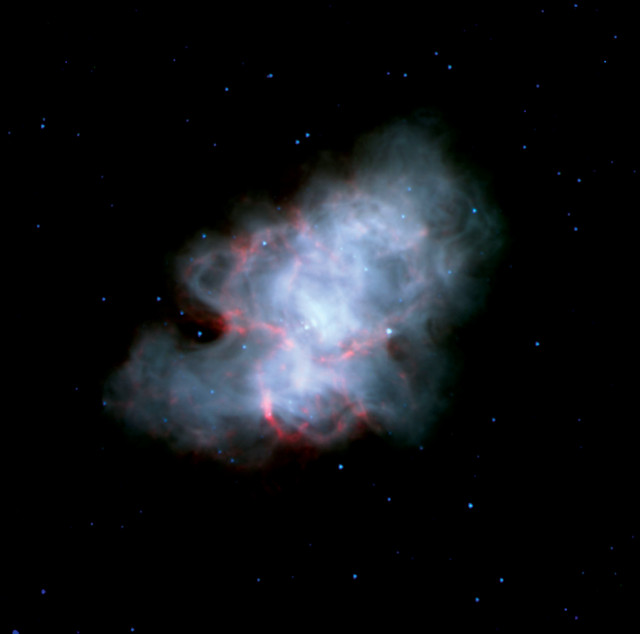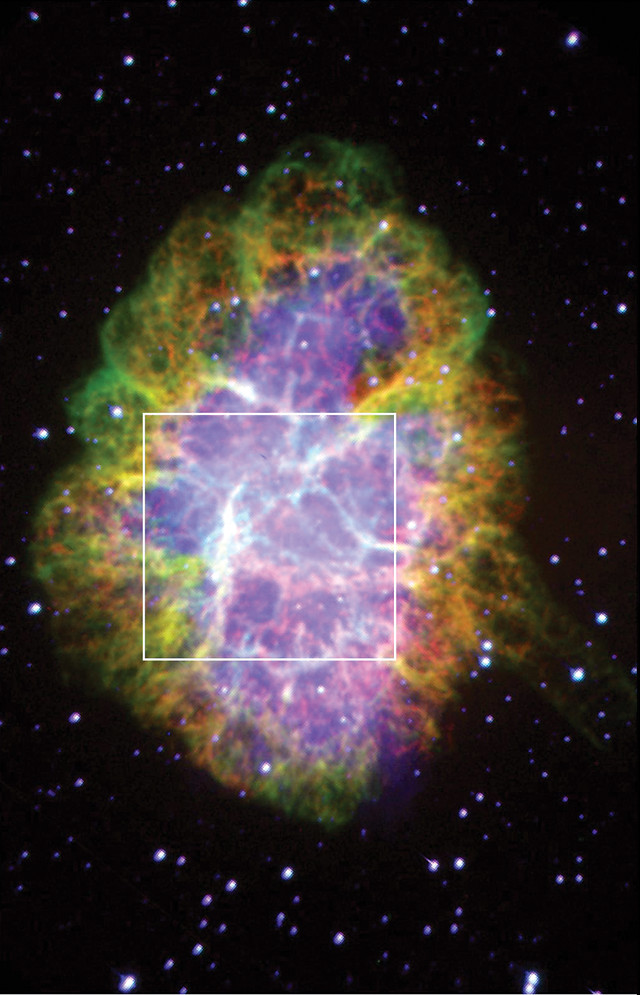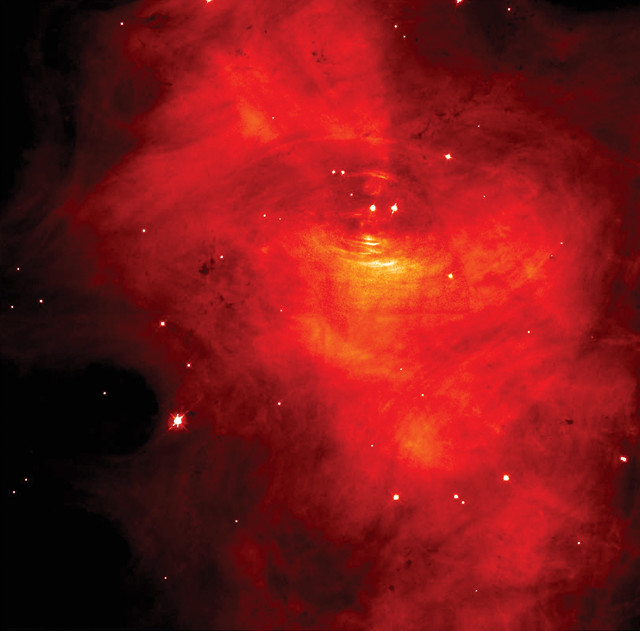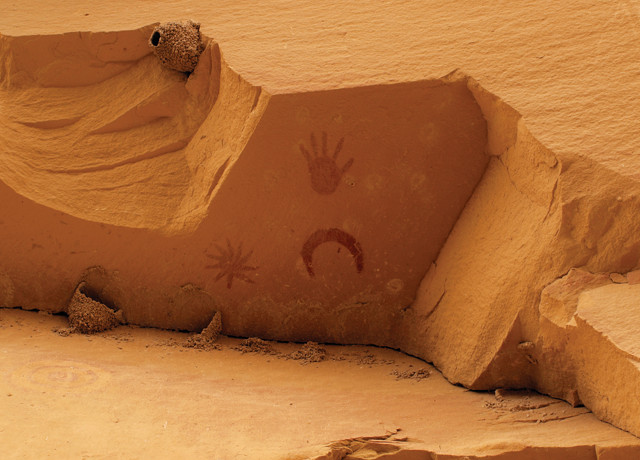
by Nate Burgess Tuesday, September 1, 2015

The Crab Nebula is all that remains of a massive star that exploded nearly a thousand years ago. Credit: NASA/JPL-Caltech/R. Gehrz (University of Minnesota).

This ground-based image of the entire Crab Nebula shows not only the collapsed core of the exploded star in the center, called the Crab Pulsar, but also the remnants of the star that were ejected into space — the green, yellow and red filaments at the edges of the nebula. Credit: Jeff Hester and Paul Scowen (Arizona State University) and NASA.
On July 4, 1054, Chinese and Japanese astronomers observed a new, iridescent yellow point of light in the constellation Taurus. This “guest star,” said to be as bright as the moon, failed to disappear with the rising sun — for a month, it shone both night and day. Even after fading during daytime, it remained in the night sky for nearly two years, by some accounts. Historians and scientists think that this event was likely the supernova that created the Crab Nebula, one of the most spectacular and rare astronomical features in the known universe.
The Crab Nebula is a complex shell of expanding gas with a dense, highly magnetized neutron star, or pulsar, at its center. Pulsars — the collapsed remnants of stars destroyed in explosions, or novae — are so named because they appear to emit radio waves in regular intervals. However, these radio pulses actually result from the star’s spinning motion. Like a revolving mirror in a lighthouse, signals reach Earth when the Crab Nebula’s pulsar beam sweeps through our space (at a rate of 30 times per second). The enormous energy generated by this spinning power station fuels the Crab Nebula’s expansion and gives its cloud of gas the brilliance of 75,000 suns.
Despite its early mark in history, when the Crab Nebula and its early supernova faded from the night sky, all memory of the event receded into anonymity for more than 600 years. In 1731, British physicist and amateur astronomer John Bevis rediscovered the Crab Nebula, noticing the ghostly body with the aide of a telescope. For the next 200 years, various scientists examined and published descriptions of the Crab Nebula, which earned its name in 1844 based on its appearance — a cloud with wispy tentacles stretching out like crab legs. In the early 20th century, astronomers such as John Duncan, while comparing photographs of the Crab Nebula, noticed that it was expanding. Duncan’s expansion rate indicated that the Crab Nebula could have originated as one of several possible novas in recorded history. With this in mind, Edwin Hubble — for whom the Hubble Space Telescope is named — suggested in 1928 that the nebula’s birth likely occurred 900 years earlier: the same time as the Asian guest star illuminated the sky. In a 1939 leaflet, astronomer Nicholas Mayall stated that the Crab Nebula was likely created by a supernova, rather than just an “ordinary nova.” He pointed out that the 1054 guest star, as described in Asian records, was consistent with this description.
Since Hubble and Mayall’s suggestion, archaeologists and historians have conducted exhaustive searches of world literature and art, seeking to corroborate the Eastern references from a thousand years ago. Astronomers have aided this work with models predicting the position of the nebula within the sky on various continents during the 11th century.

A Hubble Space Telescope image of the innermost parts of the Crab Nebula, including the Crab Pulsar. Credit: Jeff Hester and Paul Scowen (Arizona State University) and NASA.
The most scientifically useful historical references are still those in the Eastern treatises. According to the “Sung Shih,” the annual record of the Chinese Sung Dynasty, the guest star remained visible for nearly 653 days. In the “Sung-Hui Yao,” another historical document, the star appeared on July 4 and remained visible by day for 23 days. Japanese texts record a similar story, though they disagree slightly on the dates. The histories “Mei Getsuki” and “Ichidai-yoki” record the appearance of the guest star “in the orbit of Orion” between six and 16 days prior to July 4, 1054. Orion is adjacent to Taurus, the constellation where the Crab Nebula is found today. The descriptions of the star’s color and luminescence in these works allow scientists to estimate the brightness of the star and gain some perspective on what kind of celestial event this could describe.
George W. Collins II, an astronomer at Case Western University in Cleveland, Ohio, and his colleagues William P. Claspy and John C. Martin, analyzed the various historical references to the supernova in a 1999 paper. Ancient Chinese and Japanese astronomers had a relatively advanced understanding of the cosmos, they wrote — closer to modern scientific thought than other civilizations at the time. Although these astronomers still viewed celestial events in the context of omens and superstitions, they used fairly accurate positional measurements and understood a connection between events at nightfall on one day and events during early morning at a later date.
Although Eastern astronomers may have kept the most scientifically useful records of the supernova, they were almost certainly not alone in noticing the dramatic event. Native Americans seem to have recorded the event in both petrographs (rock paintings) and petroglyphs (rock carvings). In 1955, astrophotographer William Miller first connected the supernova to Anasazi rock art found in both Navajo Canyon and White Mesa in Arizona. Archaeologists have since attributed other Native American work, including a painting from Chaco Canyon in New Mexico, to the Crab Nebula supernova.
Many of these rock paintings and carvings, which appear to date from approximately the period of the guest star, feature a crescent moon in proximity to a round, often star-like object, noted astronomer John Brandt and archaeoastronomer Ray Williamson in 1979 in the Journal for the History of Astronomy. The spatial relationship between the star and the crescent moon in these pieces of art mirrors the position of the guest star within the night sky on the night of July 5, 1054.

This pictograph — thought to depict the 1054 supernova — is found in the ruins of Penasco Blanco in Chaco Canyon, New Mexico. Credit: ©iStockphoto.com/David Rock.
Despite the wealth of research on the subject of the 1054 supernova, many mysteries remain. European and Middle Eastern records of the event are scanty at best. In fact, for most of the 20th century, the only known observations of the star from these regions was an account by Ibn Butlan, a Christian physician from Baghdad who witnessed the event while travelling in the Middle East. In the last 30 years, researchers have discovered several possible references to the event in medieval European sources from Italy to Ireland — one account from a subdeacon of the Roman Church described “an orb of extraordinary brilliance” that occurred at the hour of Pope Leo IX’s death on April 19, 1054. None of these references match the detail of the Asian accounts, but they suggest the supernova may have actually exploded months before the Eastern sightings, according to Collins, Claspy and Martin.
Explanations for this curious absence of information range from censorship associated with the Great Schism between the Eastern and Western followers of the medieval Christian church — the political and religious upheaval of the time may have prompted church leaders to suppress any sightings of potential supernatural omens — to speculation that the skies were simply too overcast in Europe for people to notice the bright star.
More recent calculations of the Crab Nebula’s expansion have also called into question Hubble’s connection between the ancient guest star and the nebula. If the nebula had continuously expanded at its current rate, the supernova would have occurred more recently than 1054. But the complex processes driving the expansion of the Crab Nebula also make accurate estimates of this expansion rate difficult.
Despite these questions, history tells us that something spectacular happened in the sky sometime near July 4,1054. For better or for worse, this curious incident has now been thoroughly intertwined with the history of the Crab Nebula.
© 2008-2021. All rights reserved. Any copying, redistribution or retransmission of any of the contents of this service without the expressed written permission of the American Geosciences Institute is expressly prohibited. Click here for all copyright requests.